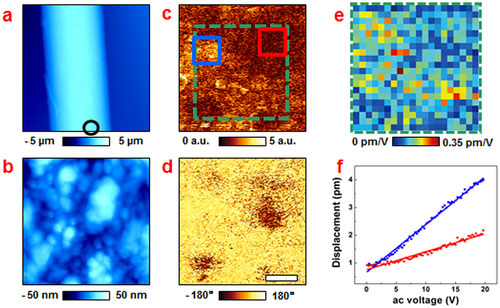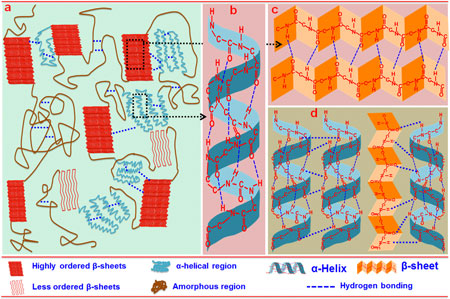| Posted: Jun 14, 2018 | |
Piezoelectric nanogenerators made from spider silk |
|
| (Nanowerk Spotlight) In our recent Nanowerk Spotlight about the use of bio-inspired piezoelectric materials as clean and sustainable green energy sources we reported on how "eggshell membranes from bio waste could be harvesters for green energy". | |
| Today we look at another example of biodegradable and biocompatible natural materials that could be used as energy harvesters – spider silk. Researchers and material scientists have long been fascinated by these ultra-strong and extensible self-assembling biopolymers that outperform the mechanical characteristics of many synthetic materials, including steel. Atomistic studies have contributed to a better understanding of the source of the strength and toughness of this amazing biological material (see our previous Nanowerk Spotlight: "Atomistic model of spider silk nanostructure paves way for new class of synthetic materials"). | |
| In new work reported in Nano Energy ("Nature driven spider silk as high energy conversion efficient biopiezoelectric nanogenerator"), a collaboration between Prof. Bhanu Bhusan Khatua's laboratory at the Materials Science Centre, IIT Kharagpur, India, and the research group of Prof. Jin Kon Kim at POSTECH in South Korea, report for the first time structure-dependent piezoelectric response of spider silk at the molecular level. | |
| Silk fibers were reported to exhibit shear piezoelectricity under applied tensile stress in the parallel direction to the fiber. | |
| "Although spider silk fibers show nature's most outstanding mechanical properties, for example, excellent tensile strength and elasticity, and remarkable protein sequence structure, it remains completely unidentified how the mechanical properties of spider silk fibers effectively contribute to the performance of a piezoelectric nanogenerator (PNG)," Khatua tells Nanowerk. "Here we successfully demonstrate that natural spider silk fibers have a definite vertical (out-of-plane) piezoelectric coefficient (∼0.36 pm/V), which has not been previously reported." | |
 |
|
| Piezoresponse Force Microscopy analysis of spider silk. (a) Topography image of spider silk covering 30×30 µm2. (b) Magnified topography image at black circled area in Fig. (a), and corresponding PFM (c) amplitude and (d) phase images. Scale bar of bd is the same (500 nm). (d) dzz spatial map of 20×20 grids, which was measured in green dotted square area of Fig. (c). (e) dzz in blue and red squared area in Fig. (c). (f) displacement vs. ac voltage curve. (© Elsevier) | |
| The team's novel approach directly makes use of the silk fibers as efficient piezoelectric material without having to apply further treatment. | |
| "So far, the piezoelectricity of pure silk fiber under external force applied vertically/out-of-plane to the direction of silk fiber has not been thoroughly investigated," says Sumanta Kumar Karan, a Ph.D. researcher at IIT Kharagpur and the paper's first author. "Nonetheless, silk fibers clearly exhibit an excellent vertical piezoelectricity as measured by Piezoresponse Force Microscopy (PFM). This unusual property of silk fibers may originate from their complex structure comprising a collection of ordered micro-fibrils, β-sheet crystal, α-helix, carbonyl group and inter/intra-molecular H-bonding." | |
| The vertical piezoelectric nature of the spider-silk was investigated through PFM study by the research team of Prof. Yunseok Kim from SKKU, South Korea. | |
| "Silk fiber is composed of amino protein based glycine and alanine blocks sequence in its primary structure level," adds Dr. Sandip Maiti, a Post Doctoral Fellow at POSTECH, who is co-first author of the paper. "At the secondary structure level, the crystalline β-sheets nanofibril domain contains short alanine chain and glycine enriched amorphous matrix consisting of α-helical and β-turn structures. The interaction between the crystalline domains and the strained elastic semi-amorphous regions could be the origin behind the extraordinary properties of silk fibers." | |
| The researchers propose a schematic diagram of β-sheet and α-helix present in silk fibers and their possible interactions. | |
 |
|
| Schematic representation of possible interactions. (a) The higher crystalline zone β-sheet, less crystalline zone β-sheet, amorphous zone and α-helical region are present in spider silk, are drawn schematically. The chemical structure of (b) α-helix and (c) β-sheet presenting in spider silk. (d) possible intra and inter- molecular interaction of α-helices and β-sheets through H-bonding. (© Elsevier) (click on image to enlarge) | |
| The team fabricated a spider silk fiber based piezoelectric nanogenerator and investigated its energy harvesting performance. Their observations revealed high output voltage (∼21.3 V) and current (∼0.68 µA) with high corresponding instantaneous power density of ∼4.56 µW/cm2, respectively, through effortless biomechanical action. | |
| "Our device also shows excellent energy conversion efficiency of ∼66%, which are the highest values among all the reported bio-based PNGs to date, to the best of our knowledge," Khatua notes. "A single flexible silk fiber PNG can turn on 30 green LEDs through simple finger imparting. An assembly of three devices in series shows a maximum output voltage of ∼65 V, which instantaneously can turn on more than 55 combined LEDs." | |
| The researchers also designed their PNG device as a one-dimensional (1D) nanowire, which maintained high significant output voltage during bending (∼5.7 V and ∼ 52 nA respectively), imparting (∼8 V and ∼77 nA) and stretching (∼3.2 V). | |
| This makes the application of 1D silk fiber PNGs as future textile nanogenerators in smart clothing feasible. Since the fabricated device is biocompatible and ultra-sensitive towards physiological signal monitoring such as arterial pulse response and throat movements, it also could be useful for potential biomedical sensor applications. | |
| The researchers are optimistic about commercializing their sensor technology, although they caution that more research is required before it can be realized in practical applications. | |
 By
Michael
Berger
– Michael is author of three books by the Royal Society of Chemistry:
Nano-Society: Pushing the Boundaries of Technology,
Nanotechnology: The Future is Tiny, and
Nanoengineering: The Skills and Tools Making Technology Invisible
Copyright ©
Nanowerk LLC
By
Michael
Berger
– Michael is author of three books by the Royal Society of Chemistry:
Nano-Society: Pushing the Boundaries of Technology,
Nanotechnology: The Future is Tiny, and
Nanoengineering: The Skills and Tools Making Technology Invisible
Copyright ©
Nanowerk LLC
|
|
|
Become a Spotlight guest author! Join our large and growing group of guest contributors. Have you just published a scientific paper or have other exciting developments to share with the nanotechnology community? Here is how to publish on nanowerk.com. |
|
